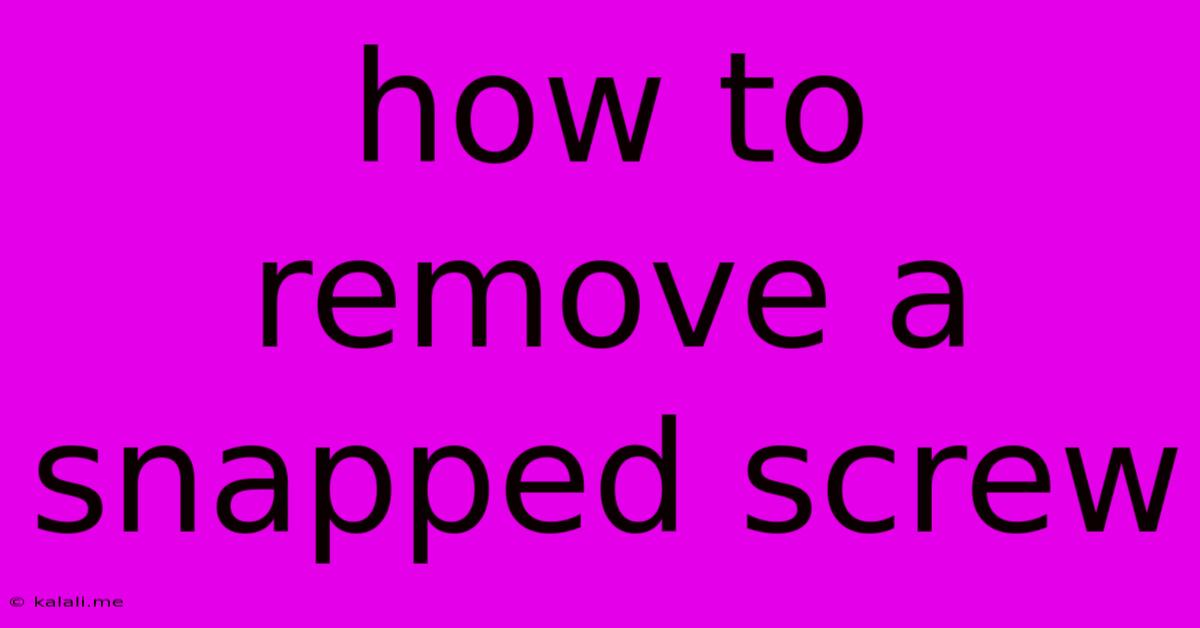How To Remove A Snapped Screw
Kalali
May 19, 2025 · 3 min read

Table of Contents
How to Remove a Snapped Screw: A Comprehensive Guide
Meta Description: Frustrated with a broken screw? This comprehensive guide provides various techniques to remove snapped screws, from simple methods like using a screw extractor to more advanced solutions for stubborn cases. Learn how to tackle this common DIY problem effectively.
Removing a snapped screw can be incredibly frustrating, but with the right tools and techniques, it's a problem you can solve. Whether it's a stripped screw head on your furniture or a broken bolt in your car engine, this guide will walk you through several methods to get that stubborn screw out.
Assessing the Situation: Type and Accessibility
Before diving in, take a moment to assess the situation. Several factors will influence your approach:
- Type of Screw: Is it a wood screw, machine screw, or a bolt? Different screw types might require slightly different removal techniques.
- Material: Is the screw made of steel, brass, or another material? Harder materials like hardened steel will be more challenging to remove.
- Accessibility: How much space do you have to work with? Limited space may restrict your tool choices.
- Depth: How deeply is the screw broken? A screw that's completely flush with the surface will be harder to grip than one that's partially protruding.
Methods for Removing Snapped Screws
Here are several methods you can try, ranging from simple to more advanced:
1. Using a Screw Extractor
This is often the most effective method for removing broken screws. Screw extractors are specially designed tools with reverse-threaded bits that bite into the broken screw and allow you to unscrew it. Choose the right size extractor to fit the size of the broken screw. Drill a pilot hole carefully to avoid damaging the surrounding material, and then use the extractor to remove the broken screw.
2. The Rubber Band Trick
For screws that are slightly protruding, a simple rubber band can provide enough grip for your screwdriver. Place a rubber band over the screw head, then position your screwdriver on top of the rubber band. The added friction will help improve your grip and prevent slippage.
3. Using a Left-Handed Drill Bit
A left-handed drill bit can sometimes work wonders. It grabs the screw's remaining threads and unscrews it as you drill. Be extremely careful not to drill too deep and damage the surrounding material. Start with a low speed and gradually increase it as needed.
4. Drilling Out the Screw
If other methods fail, you can carefully drill out the broken screw. This is a more destructive method, as it requires drilling into the surrounding material. However, it's a reliable solution when all else fails. Use a drill bit slightly smaller than the screw's diameter, and drill slowly and carefully to avoid damaging the surrounding surface.
5. Using a Dremel or Rotary Tool
A Dremel or similar rotary tool with a small cutting bit can be used to create a slot in the broken screw head, allowing you to use a flathead screwdriver. This is a good option for screws with rounded or damaged heads. This method requires precision and practice.
6. Applying Heat (With Caution!)
For particularly stubborn screws, applying heat can sometimes help. Use a soldering iron or heat gun carefully to heat the screw, which may cause expansion and weaken its grip. Be extremely cautious to avoid damaging the surrounding material. This method is best suited for metal screws.
Preventing Snapped Screws
Prevention is always better than cure. Here are some tips to avoid snapping screws in the future:
- Use the right size screwdriver: A poorly fitting screwdriver is a recipe for disaster.
- Apply lubricant: Use a lubricant like WD-40 to help the screw turn more easily.
- Don't force it: If a screw is difficult to remove, stop and try a different approach.
By following these methods and preventative measures, you'll be well-equipped to handle those pesky snapped screws with confidence. Remember, patience and the right tools are key to success!
Latest Posts
Latest Posts
-
Does Blood Fish And Bone Attract Rats
May 19, 2025
-
How Long Can You Leave Thawed Chicken In The Fridge
May 19, 2025
-
Is White Spirit The Same As Rubbing Alcohol
May 19, 2025
-
Nylon Guitar Strings On Acoustic Guitar
May 19, 2025
-
Why Does Sodium Chloride Conduct Electricity
May 19, 2025
Related Post
Thank you for visiting our website which covers about How To Remove A Snapped Screw . We hope the information provided has been useful to you. Feel free to contact us if you have any questions or need further assistance. See you next time and don't miss to bookmark.